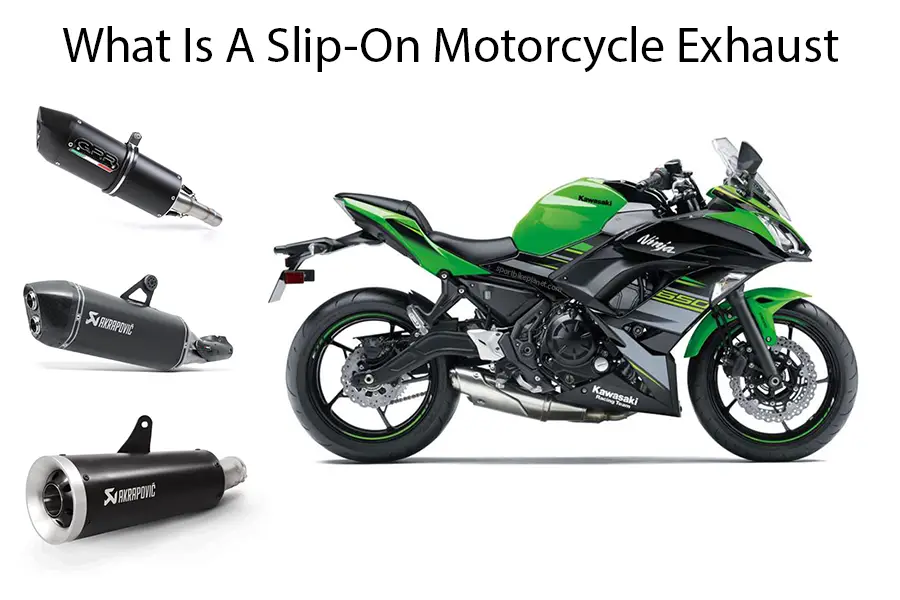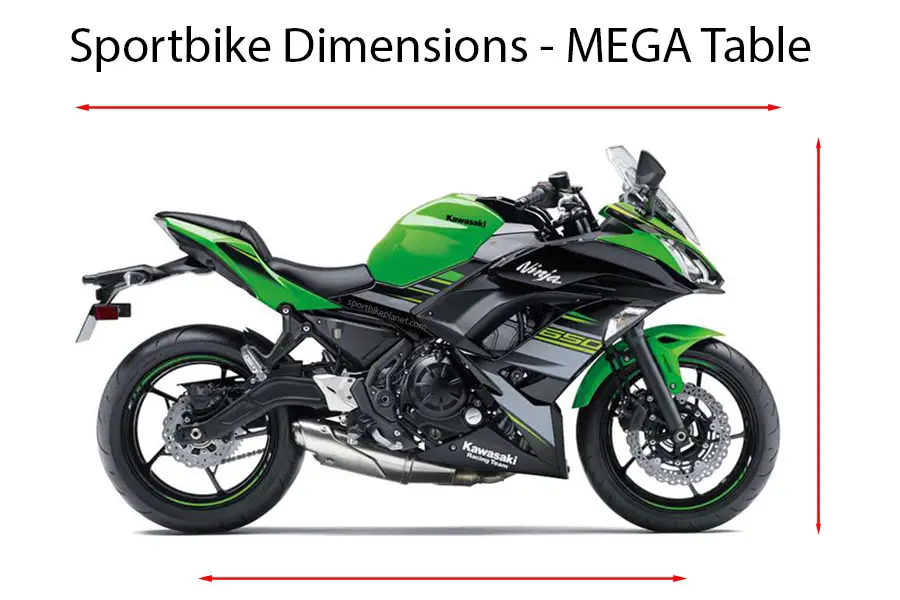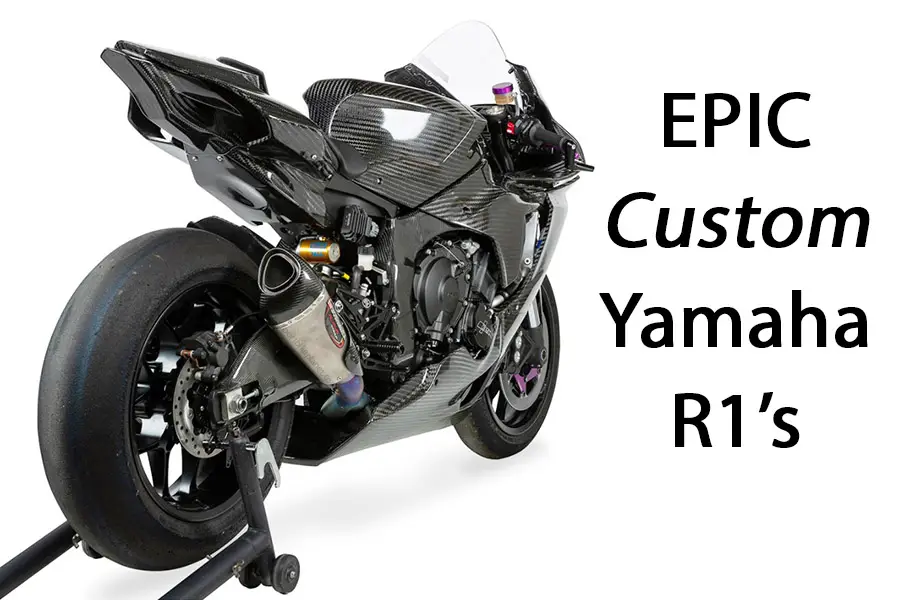To sportbike enthusiasts, a multi-cylinder engine singing by at full speed is music to our ears.
Alas, not everyone feels that way, and our sportbikes are sometimes delivered from the factory with fairly restrictive exhaust systems that lean towards quiet operation.
Happily, the aftermarket answers with a wide array of slip-on exhaust mufflers that retain the stock headers while freeing up the exhaust flow, providing us with both better performance and a more exciting exhaust note.
What a slip on exhaust actually is, however, can be a little confusing for the uninitiated…
A slip on exhaust replaces the stock muffler on a motorcycle, and simply slips into place after the stock muffler is removed. It offers riders an easy and affordable way to upgrade their sportbike both functionally and aesthetically.
What Is A Slip On Exhaust?
A slip-on exhaust can simply replaces the stock muffler unit while retaining the original head pipes and collector.
A motorcycle exhaust system has three essential parts…
The header pipes (the first part), which collect exhaust gasses directly from the cylinders directing flow towards the midpipe collector (the second part), which provides backpressure before the muffler (the third part), which in turn does exactly what it sounds like – muffles the exhaust note.
And boy, do the stock mufflers muffle.
For just a few hundred bucks, you can procure a replacement slip on canister from any number of aftermarket manufacturers and unleash the full fury.
Will A Slip On Exhaust Make My Bike Faster?
A slip on exhaust will not make your motorcycle faster, just louder. You won’t experience any significant performance gain from a slip-on muffler.
The real gains that can be had are at the other end of the four cycles.
Even if you replace your entire exhaust system with an aftermarket unit, headers and all, if you truly want or need more horsepower you’ll have to invest a product like Dynojet’s Power Commander to allow manipulation of the intake flow and fuel mapping.
A slip-on exhaust does have one substantial advantage over a stock muffler – you will almost certainly drop a few pounds by deleting the larger original equipment piece.
You can read more about the performance benefits of selecting lighter replacement parts for your motorcycle here.
Bigger gains can certainly be had by changing both the ignition and the exhaust, but realistically we don’t need that unless we’re going to the racetrack – we just want to sound racier, right?
For a relatively small investment, we can do that.
Slip-on systems are affordable and easy to install, and a recommended modification in my book.
There are too many companies making aftermarket slip-ons to count, let alone list here.
Not to denigrate anyone’s efforts, here are five of the most reputable and established exhaust system suppliers in my personal opinion based on many many years of riding and racing motorcycles.
Yoshimura

Number one with a bullet is Yoshimura.
Yoshimura was established in Japan in 1954, and has the most storied history of any aftermarket exhaust manufacturer – although, its extensive product line includes far more than exhaust systems.
Having been the title sponsor for nearly countless race teams over many decades, the accolades earned by Yoshimura cannot be overstated.
The company’s reputation in racing fairly exploded on the roadracing circuits of America nearly 50 years ago, with a Yoshimura-backed machine first winning a Superbike race in 1976.
In the years that followed, the Yosh team would sweep many podiums including the fabled Daytona 200.
Many superbike and superstock championships would follow in the decades to come.
Competing both on and off road in American roadracing, supercross, motocross, enduro, hare scrambles, and desert racing at the highest level, Yoshimura teams have since captured dozens and dozens of national titles.
As this story is written, motorcycles equipped with Yoshimura exhaust are leading the national championship in both the 240cc and 450cc divisions in AMA outdoor motocross AND in MotoAmerica roadracing!
Yoshimura consumer products are manufactured to the same high quality specifications as its race-only systems, and are available for most any sportbike – not to mention other powersports products ranging from four-wheeled ATV and UTVs to motocross bikes to scooters – and come with a one-year warranty.
As a final note, if you are interested in racing lore the multi-part Yoshimura History Series is an extensive and fascinating read.
For more information about available products, go to yoshimura-rd.com.
M4

M4 exhausts have been a staple in the MotoAmerica superbike paddock for years, both as one of the principal sponsors in the Sportbike class and its own Superbike team.
While many championships have been won with the brand, the manufacturer trickles that technology down to street riders with a full line of slip-ons that are tuned for optimum performance and sound.
Although brand association from its Superbike team might suggest that the company specializes in Suzuki, it actually makes high quality exhaust systems for virtually all brands and models.
M4 products are built to a high standard, and are easily installed.
The company offers a one-year limited warranty for its product line.
Akrapovič

Another manufacturer with a deep and storied racing history is Akrapovič.
Difficult to spell correctly with an American keyboard and also a bit unwieldy to pronounce, Akrapovič exhaust systems sound as good as they look.
This Slovenian manufacturer’s racing roots come directly from the company’s founder, Formula 1 and World Superbke champion Igor Akrapovič.
After retiring from his formidable racing career, Igor began building innovative exhaust systems in 1990 and has since become one of the top suppliers to race teams competing in virtually every major racing series in the world.
These systems are highly adaptable for street use due to the highest quality in materials and manufacturing.
The signature shape of Akrapovič’s hexagonal mufflers is both unique and beautiful.
You can see the complete line of Akrapovič products at akrapovic.com.
Graves Performance

When talking about exhaust manufacturers with a history of long term success in roadracing, Graves Performance deserves to be in the mix.
The company was the title sponsor for a team that won multiple consecutive AMA Superbike championships, and develops their street systems from the same technology that collected all those crowns.
Of particular note, Graves utilizes welding processes designed to reduce the size of its welds.
The company posits that oversized welds can lead to excessive heat build-up, and that their manufacturing process prevents possible failure and/or ovalization of the muffler.
Having stood trackside at many superbike events as Graves-backed riders roared by, I can attest that the systems have a unique and special note. Though beautiful to look at, they are distinguishable even with eyes closed.
To see the wide range of performance exhaust available through Graves Performance, go to gravesport.com.
Competition Werkes

If you’re looking for loud, a slip-on from Competition Werkes might be the muffler for you.
Though they don’t have the storied history in racing of the above companies, this relative newcomer to the marketplace actually aimed at reproducing the cacophony of an unmuffled MotoGP race bike by their own admission.
I would say they met their mark, as these are some of the loudest aftermarket exhaust systems I’ve ever been exposed to.
They are also some of the most beautiful, with gorgeous hand welding exposed for all to see.
Founded in Oregon in 2006, the company is working towards building a racing resume, and are the exhaust system of choice for the Warhorse Racing Ducati team that has nailed down a number of podium finishes in the MotoAmerica superbike series.
To see the complete line of exhaust systems available from Competition Werkes, go to competitionwerkes.com.
Material Concerns: Carbon fibere, titanium, or aluminum?
You’ll find that most manufacturers, including those listed above, offer their slip-on systems in either carbon fibre, titanium, or aluminum.
I’m a sucker for how trick carbon fibre looks, but less so for their longevity.
The biggest weight savings are to be had with carbon fibre, but they are far more susceptible to damage from vibration, re-packing, and crashing.
Should you inadvertently put your bike on the ground, carbon fibre mufflers seldom survive the impact.
Also, a muffler should be periodically serviced with new packing material.
This is relatively simple, and with most aftermarket units you simply drill out the rivets holding the end cap on, then replace with new rivets after wrapping the silencer core with packing.
Carbon chambers, however, are particularly prone to cracking around the rivet area.
For the cost conscious, aluminium canisters will be the cheapest to purchase and should last indefinitely sans any crash damage. They are also the heavier design by a minor degree.
In my opinion, the sweet spot is the titanium systems.
Titanium cans come very close to carbon fibre in heat dissipation, weigh only a tick more, and are far stronger and more durable.
Some companies, like Akrapovič and M4, still offer their designs in tried and true stainless steel.
Though these units will be among the heaviest, they will still likely be a bit lighter than your stock canister and offer the greatest longevity and reliability of all.
Secondary concerns: Decibel levels and single wall vs. double wall construction
Some aftermarket companies offer slip-ons with a removable baffle.
Leaving the baffle installed will keep you legal and be less annoying to the general public that doesn’t share our affection for a ripping exhaust note.
But they can be removed for the occasional track day to better simulate the raging superbike sound.
Single wall mufflers will of course weigh less than a double walled system, but remember that your exhaust system can be extremely hot when in use.
Most of us in my opinion ride motorbikes to get away from it all – including any significant other – but if you are one of the outliers that carries a passenger often, then I’d have to recommend a double-walled system for safety.
Sounding off: The pros and cons of slip-on sportbike mufflers
With a modern fuel injected sportbike, I’m hard-pressed to think of any cons to replacing your stock muffler with a lighter and more free-flowing exhaust other than possibly irritating your neighbors a bit more than you already do.
With older carbureted machines that can’t automatically compensate for fuel mixture needs, you may need to re-jet.
Although relatively easy, that can be a daunting task to the uninitiated.
Another caveat is that whether you choose from one of the manufacturers listed above or another, be wary of “chineseum” knock-offs and the like.
These are the epitome of you get what you pay for and that if the price seems too good to be true, it is.
Established brands research, innovate, and invest in material applications and offer superior long-term build quality.
Buy a quality muffler, and you’ll have made a quality investment in your machine.



